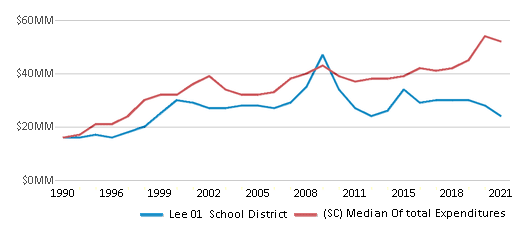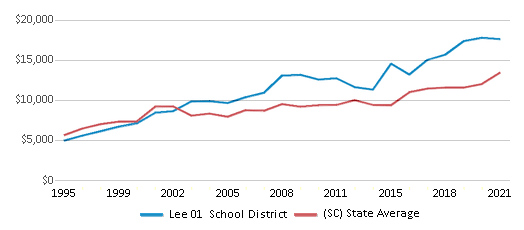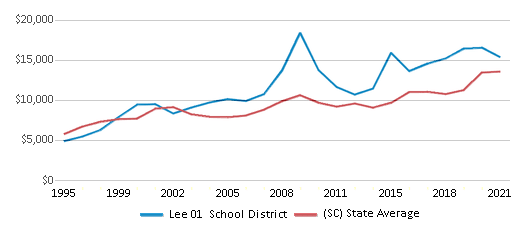Top Rankings
Lee 01 School District ranks among the top 20% of public school district in South Carolina for:
Category
Attribute
Graduation Rate
Highest graduation rate (Top 20%)
Student Attention
Lowest student:teacher ratio (Top 1%)
For the 2025 school year, there is 1 public middle school serving 338 students in Lee 01 School District. This district's average middle testing ranking is 1/10, which is in the bottom 50% of public middle schools in South Carolina.
Public Middle School in Lee 01 School District have an average math proficiency score of 9% (versus the South Carolina public middle school average of 33%), and reading proficiency score of 20% (versus the 46% statewide average).
Minority enrollment is 92% of the student body (majority Black), which is more than the South Carolina public middle school average of 52% (majority Black).
Overview
This School District
This State (SC)
# Schools
5 Schools
352 Schools
# Students
1,382 Students
221,816 Students
# Teachers
144 Teachers
15,785 Teachers
Student : Teacher Ratio
10:1
10:1
District Rank
Lee 01 School District, which is ranked within the bottom 50% of all 76 school districts in South Carolina (based off of combined math and reading proficiency testing data) for the 2021-2022 school year.
The school district's graduation rate of 90-94% has increased from 85-89% over five school years.
Overall District Rank
#78 out of 81 school districts
(Bottom 50%)
(Bottom 50%)

Math Test Scores (% Proficient)
13%
41%

Reading/Language Arts Test Scores (% Proficient)
27%
52%

Science Test Scores (% Proficient)
19%
50%

Graduation Rate
90-94%
84%

Students by Ethnicity:
Diversity Score
0.19
0.66
# American Indian Students
1 Student
716 Students
% American Indian Students
n/a
n/a
# Asian Students
n/a
3,913 Students
% Asian Students
n/a
2%
# Hispanic Students
40 Students
28,487 Students
% Hispanic Students
3%
13%
# Black Students
1,243 Students
68,879 Students
% Black Students
90%
31%
# White Students
82 Students
106,747 Students
% White Students
6%
48%
# Hawaiian Students
2 Students
263 Students
% Hawaiian Students
n/a
n/a
# Two or more races Students
13 Students
12,741 Students
% of Two or more races Students
1%
6%
Students by Grade:
# Students in PK Grade:
56
1,376
# Students in K Grade:
76
4,750
# Students in 1st Grade:
112
4,911
# Students in 2nd Grade:
107
5,020
# Students in 3rd Grade:
92
5,182
# Students in 4th Grade:
101
5,185
# Students in 5th Grade:
83
5,841
# Students in 6th Grade:
107
53,112
# Students in 7th Grade:
106
59,443
# Students in 8th Grade:
125
60,172
# Students in 9th Grade:
128
4,774
# Students in 10th Grade:
103
4,352
# Students in 11th Grade:
103
3,992
# Students in 12th Grade:
83
3,706
# Ungraded Students:
-
-
District Revenue and Spending
The revenue/student of $19,958 is higher than the state median of $15,220. The school district revenue/student has grown by 13% over four school years.
The school district's spending/student of $17,420 is higher than the state median of $14,817. The school district spending/student has grown by 13% over four school years.
Total Revenue
$28 MM
$12,084 MM

Spending
$24 MM
$11,764 MM

Revenue / Student
$19,958
$15,220

Spending / Student
$17,420
$14,817

Best Lee 01 School District Public Middle Schools (2025)
School
(Math and Reading Proficiency)
(Math and Reading Proficiency)
Location
Grades
Students
Rank: #11.
Lee Central Middle School
(Math: 9% | Reading: 20%)
Rank:
Rank:
1/
Bottom 50%10
41 Charlene Lane
Bishopville, SC 29010
(803) 428-2100
Bishopville, SC 29010
(803) 428-2100
Grades: 6-8
| 338 students
Recent Articles

Year-Round Or Traditional Schedule?
Which is more appropriate for your child? A year-round attendance schedule or traditional schedule? We look at the pros and cons.

Why You Should Encourage Your Child to Join a Sports Team
Participating in team sports has a great many benefits for children, there is no doubt. In this article you will learn what those benefits are.

White Students are Now the Minority in U.S. Public Schools
Increasing birth rates among immigrant families from Asia and Central and South America, combined with lower birth rates among white families, means that for the first time in history, public school students in the United States are majority-minority. This shift in demographics poses difficulties for schools as they work to accommodate children of varying language abilities and socio-economic backgrounds.





